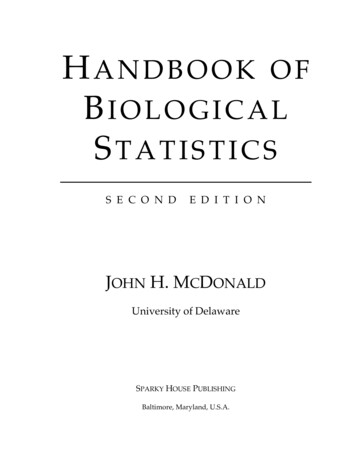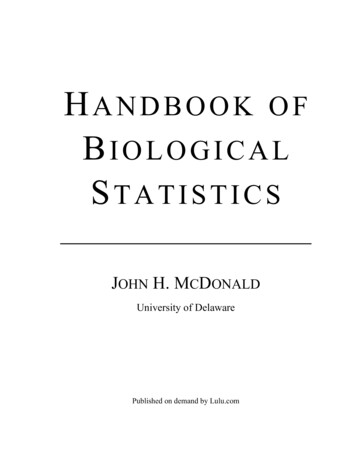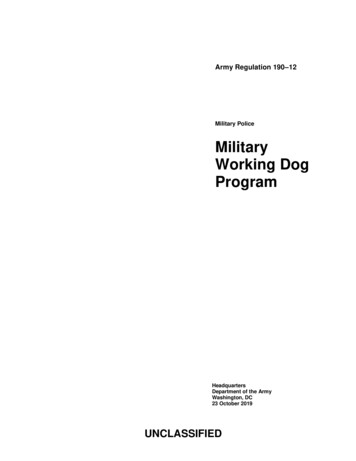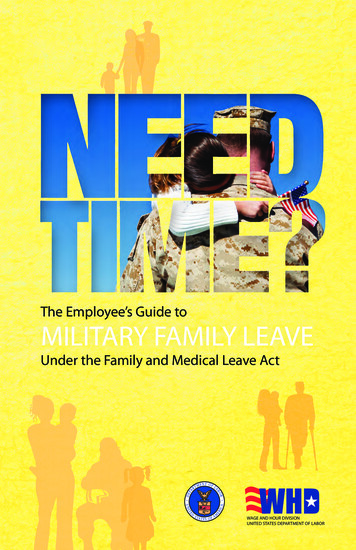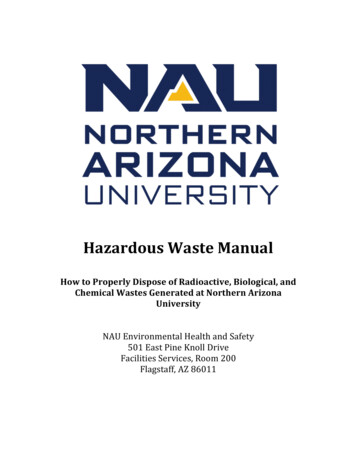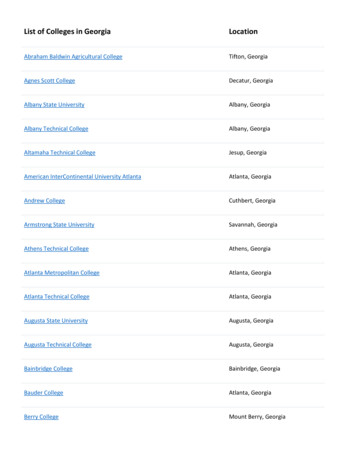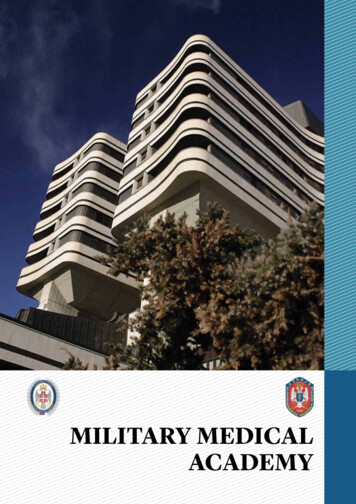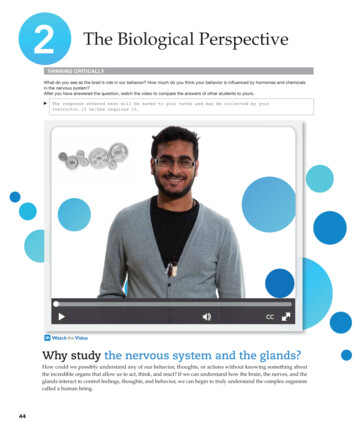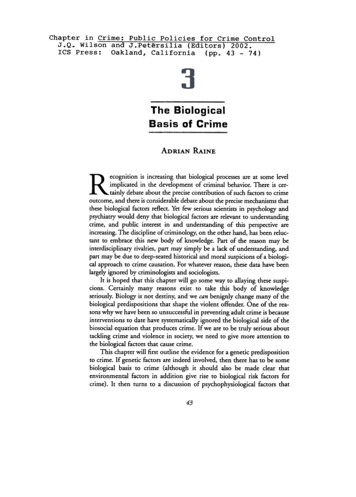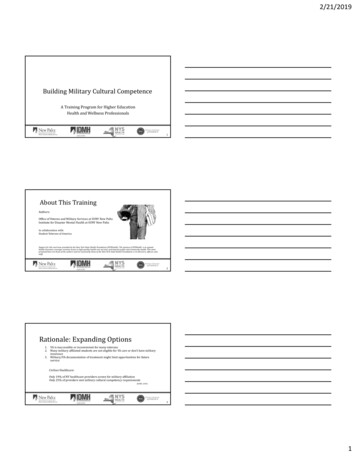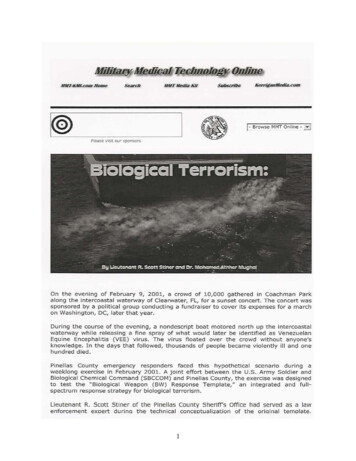
Transcription
1- Browse MMT Online- Plea se visit our sponsorsOn the evening of February 9, 2001, a crowd of 10,000 gathered in Coachman Parkalong the intercoastal waterway of Clearwater, FL, for a sunset concert. The concert wassponsored by a political group conducting a fundraiser to cover its expenses for a marchon Washington, DC, later that year.During the course of the evening, a nondescript boat motored north up the intercoastalwaterway w hile releasing a fine spray of what would later be identified as VenezuelanEquine Encephalitis (VEE) virus. The virus floated over the crowd without anyone'sknowledge. In the days that followed, thousands of people became v iolently ill and onehundred died.Pinellas County emergency responders faced this hypothetical scenario during aweeklong exercise in February 2001. A joint effort between the U .S . Army Soldier andBiological Chemical Command (SBCCOM) and Pinellas County, the exercise w as designedto test the " Biologica l Weapon (BW) Response Template," an integrated and full spectrum response strategy for biologica l terrorism .Lieutenant R. Scott Stiner of the Pinellas County Sheriff's Office had served as a lawenforcement exoert durina the technical conceotualization of the oriainal temolate.1
owl ,0Looking to tap Stiner's expertise, team leaders at SBCCOM asked if he would be wil l ingto take a lead role in exercising and testing the response concepts embedded within thetemplate. Lieutenant Stiner agreed to help and subsequently sought support from DavidBilodeau, Director of Emergency Management for Pinellas County. Director Bilodeau wasenthusiastic about the opportunity to be one of the first counties in the country to gainexperience in this type of exercise.For more than a year, SBCCOM technica l experts in biological weapons met with acounty planning committee to design the exercise. During the course of these meetings,new contacts and friendships developed among law enforcement, firefighters, emergencymedical services (EMS) and-joining them at the table for the first time-public healthofficials. Little did any of these participants know that these new relationships would beinstrumental in dealing with real-world anthrax cases later that same year.Investigating Acts of Biological Terrorism-the Role of EpidemiologyBy definition, terrorism is a criminal act that warrants a full spectrum of criminalinvestigation activities, including evidence collection, victim interviews, identification a ndisolation of the crime scene, and apprehension and prosecution of suspects. However,the characteristics of biological terrorism present unique challenges to the lawenforcement community. In the event of a bioterrorism incident, for example, while thelaw enforcement community performs its traditional criminal investigation, the medicaland public health community will conduct its own epidemiological investigation toidentify and control the disease outbreak .Epidemiology involves the study of the incidence and distribution of diseases in largepopulations, and the conditions i nfluencing their spread and severity. Epidemiologistscollect information through victim interviews and case tracking. This information canhelp public health practitioners identify the population at risk, the geographic source andthe disease agent strain. All this information is key to the criminal investigation as well.While the epidemiological and criminal investigations may occur contemporaneously,information is not necessarily shared between the public health and the law enforcementcommunities. In the case of biological terrorism, the criminal and the epidemiologicalinvestigations could-and l ikely should-complement one another. For instance, onceepidemiologists identify the source of the outbreak, or the time and place of the agent'srelease, criminal investigators could visit the site to collect evidence and other datapertinent to law enforcement concerns. Because neither community is accustomed toworking with the other, it is possible that informat ion that could benefit one or bothinvestigations will not be exchanged.Tackling the ProblemIn an effort to close this gap, SBCCOM partnered with the National DomesticPreparedness Office (NDPO) to sponsor an analytical workshop in January 2000. Thegoal was to ident ify ways to establish information-sharing relationships between the lawenforcement and the public health communities to ensure a timely and appropriateexchange of information during bioterrorism investigations. Worki ng through astructured, intensive three- day workshop, a panel of law enforcement and public healthprofessionals identified when it is important for these two communiti es to shareinformation, what information is needed for each investigation, and how eachcommunity could improve its information exchange with the other."When Should We Share?"2
One of the most difficult decisions in any incident would be determining what events orinformation should trigger the exchange of information between the law enforcementand public health communities. For example, the law enforcement community shouldconsider sharing information with epidemiologists: when intelligence indicates that disease agents w ere intentionally used to harmsomeone when there is an indication that criminal or terrorist elements are involved with aserious illness or death upon seizure of bioprocessing equipment from any individual, group ororganization upon seizure of any potential dissemination devices from any individual, group ororganization upon identification or seizure of literature pertaining to the development ordissemination of biological agents when any assessments indicate a credible biological threat in an area.The epidemiological community, too, has a number of triggers that would compel themto share information with law enforcement. These include: unusually large numbers of patients with similar symptoms or diseaselarge numbers of unexplained symptoms, diseases or deathsa single case of an uncommon diseasedisease with an unusual geographic or seasonal distributiondisease transmitted through aerosol, food or water (suggestive of sabotage)death or illness among anima ls that may be unexplained or attributed to aclassical agent of biological warfare.What Information Is NeededThe workshop panel recommended that each community-law enforcement and publichealth-use a prepared list of general questions that they could ask victims or patientsto aid the other's investigation. Although this approach does not eliminate the need forlaw enforcement and public health personnel to conduct their own interviews andinvestigations, it reduces the need to interview the same people twice to obtain similarinformation.Table 1 contains personal and famil y health information that can help epidemiologistsget an initial impression about an outbreak's extent. Questions about a v ictim 's activitiescan help identify the potential point of origin for the infectious agent. This informationalso provides clues regarding the potential secondary spread of the disease if the agentis communicable. Dissemination devices, affected animals, or unusual tastes and odorscould help distinguish between a naturally occurring outbreak and an intentional release.Who Needs This Information and WhenThe best information is useless unless the right people get and use it on t ime. For this tohappen in a timely manner, it is essential to establish key communication pointsbetween the law enforcement and public health communities. The law enforcementcommunity needs to initiate its criminal investigation as soon as possible to preclude theloss of critical evidence or disturbance of the crime scene. The epidemiology communitywants to positively identify the agent so t hat appropriate medical treatment can beadministered and measures taken to protect the remainder of the community from3
exposure.The challenge for the workshop panel was to find common modes of informationexchange between two communities that traditionally have worked separately from eachother. This challenge is compounded by the fact that even within law enforcement andpublic health communities, each jurisdiction is different in terms of its specific roles andresponsibilities. Indeed, some departments and positions may not even exist in somelocalities. Acknowledging these differences, the wo rkshop panel developed a set ofrecommendations that provide general guidance that any jurisdiction can use toestablish a structure for improved communication exchange that is consistent withexisting emergency-response protocols.Strategies to Improve Information Exchange and CollaborationAs part of its own homeland defense initiatives, each jurisdiction can establish aninformation-exchange group consisting of all the potential players in a response to abiological incident. These p layers could include public health officials, the lawenforcement community, local private and public hospitals, EMS groups, firefighters1HAZMAT teams, emergency management officials, representatives of agencies inadjoining communities that may be called to respond, and state and federal agenciesthat may have a role.This forum allows each response group to identify who can provide what information towhom, specifically, and when they should provide it. Much more than providing for asterile, mechanical exchange of information, this group helps foster personal tiesbetween response officials, facilitating less formal modes for sharing information.Several of the exercise's practicing response experts indicated that they would be morelikely to provide information to their counterparts early and often in the process if theyhad worked, talked o r met with them on a regular basis.To further improve the exchange of information, criminal investigators could considerincluding an epidemiologist on their staff on a part-time basis. This liaison could helpidentify information arising from a criminal investigation that would be of significance tothe public health community. At the same time, the epidemiologist would become betteracquainted with criminal investigation needs and procedures.Thelocal emergency response community,including firefighters,emergencymanagement officials, hazardous-materials crews and other emergency responders,should be trained to have at least an awareness of biological incidents. T his awarenesswould heighten t he community's overall ability to recognize factors that should triggerthe exchange of information early in an incident.The local community could also develop internal agreements that identify the protocolfor the exchange and release of information. These agreements should identify whatinformation will be shared, how it w ill be used and how it will be restricted to limitaccidental release to unauthorized personnel.Finally, the local jurisdiction should ensure that public health practitioners are educatedon "chain- of-custody" procedures for clinical or medical samples that are to be used asevidence in the investigation and prosecution of a biological crime.The Anthrax Attacks : Applying the FindingsAs the United States grieved the horror of September 11, a new form of terror grippedthe nation in early October 2001: anthrax. With the first death occurring only 200 m iles4
from Pinellas County, the region's citizens became afraid to open any piece of mail thatlooked remotely suspicious. Emergency switchboards lit up with more than 300 911 callsin the first 30 days.Given the magnitude of the attacks on New York City and the Pentagon, emergencyresponders in Pinellas County could not be sure that this new threat was not real andthat it did not represent a large-scale secondary attack on the country. As deputiesbegan to respond, they became concerned about safety and how to best handle thesetypes of calls.But thanks to the contacts that were made during the February 2001 exercise, and perthe findings of the SBCCOM/NDPO workshop, a meeting bet ween fire, HAZMAT, lawenforcement, EMS and public health was pulled together in a matter of a few hours.Working as a team, participants quickly developed a multi-agency, cross-functionalprotocol for how the county would respond to this crisis.During the weeks that followed the September 11 attack, first-responders in PinellasCounty handled more than 630 calls regarding suspicious mail. The protocol described inthe accompanying sidebar was used on each call. Readers are encouraged to review theprotocol and adapt portions relevant to their specific circumstances and jurisdictions.America is forever changed by the horrific events of September 11 and by the anthraxpanic that followed. We can no longer take for granted that American soil is safe fromterrorism . As our leaders and citizens work to balance liberty and vigilance, members oflaw enforcement must now learn to prevent, i nvestigate and p rosecute a new form ofterrorism .Questions that Law Enforcement Can Ask toHel p EpidemiologistsQuestions That Epidemiologists Can Ask t:o Help LawEnforcementPersonal / Family Health InformationPersonal Information What do you think made you ill? When (date/ t ime of onset) did you start What is the victim's name, age, date of birth, sex,address, social security number, driver's licensenumber, occupation/employer? What is the victim's religious affiliation? What is the victim's level of education? What is the victim's ethnicity/nationality?feeling sick? Do you know of anyone else who hasbecome ill or died - e.g. family, coworkers,etc.?Have you had any medical treatment in thelast month? What is the name of thehealthcare provider? Where were youtreated?Travel Information Have you traveled outside of the United States in Have you traveled away from home in the last 30days?Activities Information Where do you live and work/go to school? Did you attend a public event - i.e. sportingevent, social function, visit a restaurant,etc.? Have you o r your family members traveled Have you or your family members had anycontact with individuals who had been inanother country in the last 30 days?t he last 30 days? What is your normal mode of transportation androute to and from work every day? What kinds of activities have you been engaged infor the last 30 days?more than SO miles in the last 30 days?Incident Information Has the victim heard any unusual statements - i.e.t hreateningAgent Dissemination Informationstatements or conversationbioloaical aqents?5about
Did you see an unusual device or anyonespraying something? Have you detected any unusual odors orHave you noticed any sick or dead animals? Have you seen any laboratory equipment orother suspicious activities?What is the time/date of exposure? Is the time/ datesuspected, presumed or confirmed ?tastes? What is the victim's account or explanation of howhe/she might have gotten sick? What are the potential modes of exposure - e.g. Where is the exact location of the incident? Is thisingested, inhaled, skin contact?suspected, presumed or confirmed? Was this a single- or multiple-release incident? Isthis suspected, presumed or confirmed? What physical evidence did you see at the site ofexposure? Did anyone else witness or speak about a suspiciousincident? What are their names?Dr. Mohamed Mughal has more than 17 years experience researching and analyzingchemical and biological warfare and terrorism and has published extensively on thosetopics.Lieutenant R. Scott Stiner is assigned as the disaster-preparedness coordinator for thePinellas County Sheriff's Office in Florida. He is currently under contract with the SoldiersBiological Chemical Command, U.S. Army, working on national plans to react to andmitigate the consequences of a terrorist attack involving weapons of mass destruction.6
Biological Chemical Command (SBCCOM) and Pinellas County, the exercise was designed to test the " Biological Weapon (BW) Response Template," an integrated and full spectrum response strategy for biological terrorism. Lieutenant R. Scott Stiner of the Pinellas County Sheriff's Office had served as a law
